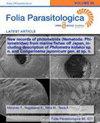First report and molecular characterisation of Rhabdochona hospeti Thapar, 1950 (Thelazioidea: Rhabdochonidae) from tor barb, Tor tor (Hamilton) (Cyprinidae), in Assam, India
IF 1.5
4区 医学
Q3 PARASITOLOGY
引用次数: 0
Abstract
Tor barbs, Tor tor (Hamilton), a cyprinid fish collected from Barak Valley, Assam, India were examined for helminth parasites. A nematode species of the genus Rhabdochona Railliet, 1916 (Rhabdochonidae) was found in the intestine of the fish specimens. The morphology of these nematodes was characterised by the presence of a funnel shaped prostom, head with four submedian sublabia, four cephalic papillae, long and slender posterior glandular oesophagus in both sexes, presence of 14 caudal papillae and two unequal spicules with pointed proximal tips in male specimens, and prominent post-equatorial vulval position, posteriorly directed vagina, uterus with fully scattered eggs in female specimens, and a tail pointed with a small mucron in both sexes. This nematode species was subsequently identified as Rhabdochona hospeti Thapar, 1950, reported herein for the first time in the northeastern India. In addition to its morphological description based on light microscopy, partial 18S and 28S rDNA sequences were generated to assess phylogenetic relationships of R. hospeti with other species of Rhabdochona.首次报道印度阿萨姆邦托尔托尔(汉密尔顿)(鲤科)的医院Rhabdochona hospeti Thapar, 1950(蜱总目:Rhabdochonidae)的分子特征
对采自印度阿萨姆邦巴拉克谷的一种鲤科鱼Tor barbs, Tor Tor (Hamilton)进行了寄生虫检查。1916年在鱼标本的肠道中发现了一种横纹肌线虫属(横纹肌线虫科)。这些线虫的形态特征是:两性均有漏斗状的前体,头部有4个正中下唇,4个头状乳头,长而细长的后腺状食道,雄性标本有14个尾状乳头和2个不相等的针状体,近端尖尖,突出的后赤道外阴位置,阴道朝后,雌性标本子宫卵完全分散。两性的尾巴都是尖的,有一个小茸毛。该线虫物种随后被鉴定为Rhabdochona hospeti Thapar, 1950,在印度东北部首次报道。在光镜下对其形态进行描述的基础上,生成了部分18S和28S rDNA序列,以评估其与其他种横纹肌的系统发育关系。
本文章由计算机程序翻译,如有差异,请以英文原文为准。
求助全文
约1分钟内获得全文
求助全文
来源期刊

Folia Parasitologica
医学-寄生虫学
CiteScore
2.70
自引率
0.00%
发文量
25
审稿时长
>12 weeks
期刊介绍:
FOLIA PARASITOLOGICA, issued in online versions, is an international journal that covers the whole field of general, systematic, ecological and experimental parasitology. It publishes original research papers, research notes and review articles. Contributions from all branches of animal parasitology, such as morphology, taxonomy, biology, biochemistry, physiology, immunology, molecular biology and evolution of parasites, and host-parasite relationships, are eligible. Novelty and importance in the international (not local or regional) context are required. New geographical records of parasites, records of new hosts, regional parasite and/or host surveys (if they constitute the principal substance of manuscript), local/regional prevalence surveys of diseases, local/regional studies on epidemiology of well known diseases and of parasite impact on human/animal health, case reports, routine clinical studies and testing of established diagnostic or treatment procedures, will not be considered. One species description will also not be considered unless they include more general information, such as new diagnostic characters, host-parasite associations, phylogenetic implications, etc. Manuscripts found suitable on submission will be reviewed by at least two reviewers.
 求助内容:
求助内容: 应助结果提醒方式:
应助结果提醒方式:


